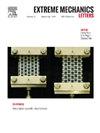A coarse-grained model for nanocellulose with hydration interfaces revealing the anomalous mechanical enhancement
IF 4.3
3区 工程技术
Q2 MATERIALS SCIENCE, MULTIDISCIPLINARY
引用次数: 0
Abstract
Considering the humidity-sensitivity of nanocellulose, decoding the micromechanical mechanisms hidden in hydration interface is essential for tailoring the macroscopic properties. However, exiting mechanics frameworks based on molecular modeling remain challenging to predict the hydration interface-mediated mechanical behaviors of nanocellulose at the mesoscale, hindering the correlation from micro-interface to macro-mechanics. Herein, we developed a coarse-grained (CG) model integrating non-covalent interactions and fiber-level hierarchical stacking, which unveils the anomalous mechanical enhancement of nanocellulose with hydration interfaces. The CG model, validated by all-atom (AA) simulations, accurately captured the modulus and strength scale law with overlap length, until the fiber fracture-dominated saturated state. Our results revealed how hydration extent effects the interfacial mechanics, showing that moderate hydration can enhance both toughness and strength by plasticizing hydrogen-bonding networks, while excessive hydration weakening the shear strength. Beyond the limit that AA simulations can predict, an optimal overlap regime (∼120–180 nm) was identified, where hydration-mediated interfaces can enhance the strength and toughness simultaneously. This study established a cross-scale theoretical modeling framework bridging the microscale hydration interface and macroscale mechanical regulation of nanocellulose materials, which can provide the bottom-up rational guidance for designing strong and tough nanocomposites with weak non-covalent interfaces.
具有水化界面的纳米纤维素的粗粒度模型揭示了异常的机械增强
考虑到纳米纤维素的湿度敏感性,破译隐藏在水化界面中的微观力学机制对于调整纳米纤维素的宏观性能至关重要。然而,现有的基于分子模型的力学框架仍然难以在中尺度上预测纳米纤维素水化界面介导的力学行为,阻碍了微观界面与宏观力学之间的关联。在此,我们开发了一个整合非共价相互作用和纤维级分层堆叠的粗粒度(CG)模型,该模型揭示了水化界面对纳米纤维素的异常机械增强。CG模型经过全原子(AA)模拟验证,准确地捕捉了纤维模量和强度随重叠长度变化的尺度规律,直到纤维断裂为主的饱和状态。我们的研究结果揭示了水化程度对界面力学的影响,表明适度的水化可以通过塑化氢键网络来提高韧性和强度,而过度的水化则会削弱抗剪强度。在AA模拟可以预测的极限之外,确定了最佳重叠区域(~ 120-180 nm),其中水化介导的界面可以同时提高强度和韧性。本研究建立了连接纳米纤维素材料微观水化界面与宏观力学调控的跨尺度理论建模框架,可为设计具有弱非共价界面的强韧性纳米复合材料提供自下而上的理性指导。
本文章由计算机程序翻译,如有差异,请以英文原文为准。
求助全文
约1分钟内获得全文
求助全文
来源期刊

Extreme Mechanics Letters
Engineering-Mechanics of Materials
CiteScore
9.20
自引率
4.30%
发文量
179
审稿时长
45 days
期刊介绍:
Extreme Mechanics Letters (EML) enables rapid communication of research that highlights the role of mechanics in multi-disciplinary areas across materials science, physics, chemistry, biology, medicine and engineering. Emphasis is on the impact, depth and originality of new concepts, methods and observations at the forefront of applied sciences.
 求助内容:
求助内容: 应助结果提醒方式:
应助结果提醒方式:


